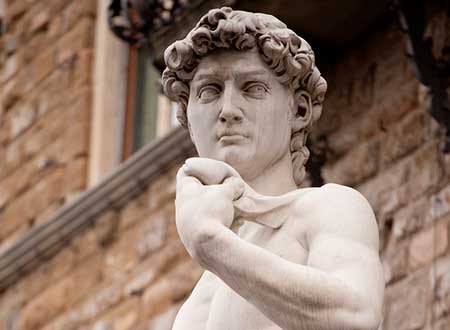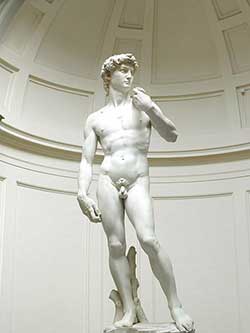Michelangelo’s David is a large sculpture. He’s close to 17 feet tall. Since 1873, David has stood on a large pedestal at the Accademia Gallery in Florence. The pedestal makes him seem even taller than his 17 feet. It is strange, really, that David should be so tall. As everybody knows, Goliath was the giant, not David. David was more or less a little guy. He was a youth, and ruddy, and of a fair countenance, as the Book of Samuel tells us. David manages to kill the giant Philistine warrior Goliath by hitting him in the head with a stone. Then David takes the giant’s sword and chops his head off. Saul, king of the Jews at the time, wonders, “Who is this kid?” That’s the biblical story of David and Goliath.
Michelangelo chose to make David — the giant-killer — into a giant himself. Mostly this has to do with accidents of history and dumb luck. There was a huge piece of marble lying around Florence in the 15th century. A couple of sculptors had tried to make a statue of it. But the block was tricky to work with, so tall and thin. No artist was yet up to the task. In 1501, Michelangelo, 26 years old at the time, said he could do the job. He promised to bring David out of the marble.
David was a special figure for Florentines. This was Italy during the Renaissance: a collection of city-states and principalities usually at war with one another. This was a time of warrior popes and family feuds that killed hundreds. The people of Florence wanted to see themselves in David. Florence was the little city that could stand up to all the others. Plus, Florence had the powerful banking family, the Medici, to deal with. The Medici were always threatening to dominate Florence, economically and politically. In the late 15th century, the city kicked the Medici out of Florence. Defying the Medici was another David-like act. Problem was, the Medici had already commissioned a sculpture of David. That’s the famous statue by Donatello. With the ousting of the Medici, the people of Florence wanted to commission their own David. They wanted to take back the symbol for themselves.
So, Michelangelo solved two problems at once. He solved the technical problem of making a giant sculpture out of a giant block of marble. And he solved the problem of political symbols by creating a statue so overwhelming to behold that David would forever be associated with the Republic of Florence. The irony is that Michelangelo had learned to sculpt under the patronage of the Medici family, but his most famous work was a repudiation of their claims over the city.
•
Spectacular as David’s body is in Michelangelo’s sculpture, I think you have to see the body as basically a pillar. Because the block of marble that Michelangelo was working with was tall and thin, Michelangelo had to make a tall, thin David. Michelangelo did his best to make the figure supple, tense with motion. He gave David’s hip a little twist and had him stand in a classic contrapposto, the majority of his weight on the right leg. But in the end, David’s body conveys a tremendous sense of pillar-like verticality. The pillar of David’s body holds up an enormous head. David’s body is very much for his head. You don’t notice this so much if you look at the sculpture straight on. Standing right in front of his torso, David’s head is turned to the left and his facial features look almost benign. But if you move to the side and look at David from his left, the face really comes alive. David is fierce, even slightly crazed.

A David replica at the Palazzo Vecchio.
David looks out, presumably at the approaching Goliath. His body is loose, but ready to move. He sees what he has to do. In a few minutes, it will all be over. If only life were this easy all the time. A clear task. A young body at the command of a brave heart. Matter and spirit united in decisive action. That is the way heroes must feel.
Florence felt that way about itself in the early 16th century. Michelangelo felt that way about himself in the early 16th century. The man and the city held themselves in high regard.
•
Any night, you can walk along the streets of Florence up to the Piazza della Signoria. The square opens up into a grand viewing platform by which to look at the Palazzo Vecchio, which is basically the Town Hall of Florence. Michelangelo’s David once stood outside the Palazzo. A copy of David stands there now, across from Bandinelli’s statue of Hercules, another giant slayer.
The Palazzo is a massive building from the early 14th century, topped by a tremendous tower. The lights around the Piazza, at night, sparkle against its stones and glass windows. It is a fierce building. The top of the tower is perched there, keen and glowering, watching the hills of Tuscany as if Goliath might come striding over them tonight.
Inside, the Palazzo is a tangle of interlocking courtyards. Frescoes depict the battles of Florence, the victories over enemies. But it is hard to track, at any moment in Florence’s history, just who is the enemy. They are everywhere, these enemies: Sienna, Milan, the Pope, French kings, other Italian city-states. Then there are the internal enemies: the Medici, noble families feuding against one another, Savonarola (embraced as a savior and then burned at the stake on this very Piazza).
In protection against whom are the high buildings of Florence? During Michelangelo’s time there were many more towers all around Florence, Davids standing as sentinels in the city. But these towers served internal wars. A dispute would break out between families. And then the streets were no longer safe. An orgy of killing would break out. Barricades were set up, ambushes. To keep safe, the nobles would retreat to their towers. Up in those high windows, they would look down on the killing streets below.
Standing tall, the towers of Florence looked for enemies outside. But always, the violence was internal.
The little medieval streets of Florence become quiet when the sun goes down. It is still a city of bankers, after all. And up around the corner is the flickering of light, the shadows of human figures huddled together on a cool evening in early autumn. Is it one of the families of Florence, waiting to pounce on their rivals in a late-night act of revenge? No. It is only kids drinking wine and smoking cigarettes.
•
A few years after Michelangelo finished David, the Medici found their way back to power in Florence. Michelangelo had designed the fortifications that were meant to keep Florence safe from the Medici and whatever army they raised to come back. But the Medici were too rich, too powerful. They came back. Michelangelo moved to Rome. He was working with the Popes, who were in cahoots with the Medici. Despite his allegiance to Florence, Michelangelo was constantly engaged in projects meant to glorify the Medici name, like the famous Medici Chapel. Michelangelo was implicated in all of it; the dirty politics, the money, the bullshit, the beauty. A slave to the Popes. A slave to the Medici. A slave to his own genius.
During the night, Michelangelo would read the writing of the Neoplatonists, men like Pico della Mirandola. The body, Michelangelo would read, is not a thing of strength, not a pillar holding up the crown of the head. It is a prison.
The great 20th century art historian Erwin Panofsky put it like this:
While the Neoplatonic belief in ‘the presence of the spiritual in the material’ lent a philosophical background to [Michelangelo’s] aesthetic and amorous enthusiasm for beauty, the opposite aspect of Neoplatonism, the interpretation of human life as an unreal, derivative and tormenting form of existence comparable to a life in Hades, was in harmony with that unfathomable dissatisfaction with himself and the universe which is the very signature of Michelangelo’s genius.
Slowly, over his career, the statues of Michelangelo began to show the body in collapse, turning inward and doubling over.
•
Down the hall from Michelangelo’s David in the Accademia Gallery are The Slaves. They were sculpted when Michelangelo was a much older man, intended originally as part of a tomb for Pope Julius II, the same Pope who forced Michelangelo to paint the Sistine Chapel. The original version of the tomb was never made. The Slave sculptures were never completed.
Without knowledge of Michelangelo’s career, it would be impossible to know that David and The Slaves were created by the same man. The Slaves writhe and twist. It is often said that The Slaves are trying to escape from the stone in which they are trapped. Partly this is true. Michelangelo never finished the work that would have freed them. But even in finished form they would squirm and struggle against their fetters. What are these fetters? Probably they are the fetters of matter itself. Or worse. They are trying to escape from what they are. They are trying to escape from what is inside. Or not even trying to escape. Just struggling. Locked in a struggle that cannot be won. It is simply endured.
The Slaves twist and torque. The bodies do not stand up, as David does. They turn over on themselves. David glared out at the world, defiant in his self-regard. The Slaves collapse under the strain of regarding the self. The Slaves do not meet anyone’s gaze. There is no need to do so. There is no one to look at. The enemies are not out there. The Slaves twist around on their own axes. This is the beginning of the infamous figura serpentinata, the “snake pose” of later Mannerist art. Artists after Michelangelo will contort the body, in sculpture and painting, into all manner of grotesque poses. It became a fad of sorts, the figura serpentinata.
Looking at Michelangelo’s Slaves, however, we can only assume that he achieved the serpentinata by honest means. That’s to say, Michelangelo had his own serpent, turning and twisting, collapsing within. Not a fad, but a genuine spiritual struggle, the results of which are left to us in stone.
Hanging on the wall of the Accademia Gallery, just behind Michelangelo’s Slaves, is a painting by Andrea Del Sarto. It is a pieta. Christ is shown after his removal from the Cross. But Christ is alone in this painting, without the usual compliment of figures: Mary, John, Nicodemus. Christ sits on a stone outcrop, hands and feet pierced. He is dead. But he could he alive, the way he sits there. It is as if he is looking down at his body in a mixture of shock and amazement. What is this flesh? What do I do with it? Christ finally asks himself the question, “Am I really just this body, or something more?” Del Sarto shows us Christ in that moment of questioning, before there is any possible answer. Michelangelo found himself, more than likely, in that same position more than once. He hadn’t lost hope. But he had discovered something about what hope looks like in the poses of the human body. It doesn’t look like David, a young man’s fantasy, the fantasy of a powerful city in a moment of optimism. It looks like the Slaves. Broken down, turned inward, marked by a nameless, unfathomable suffering. • 11 December 2013




